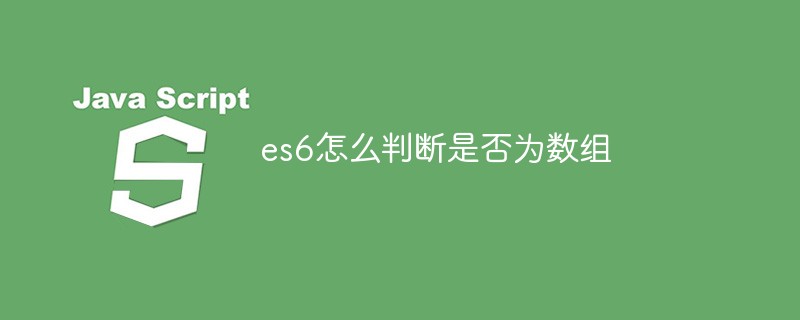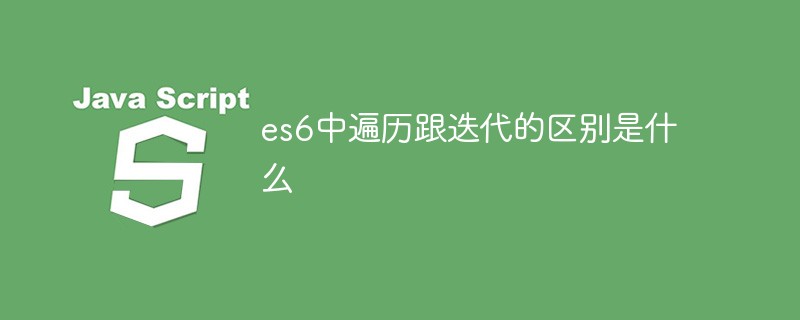There are two types of es6 decorators. Decorators can only be used for classes and class methods, so they can be divided into: 1. Class decorators, used to decorate the entire class, the syntax is "@ function name"; 2. Class method decorators, used to decorate methods of the class , the syntax is "@ function name method name".

The operating environment of this tutorial: Windows 10 system, ECMAScript version 6.0, Dell G3 computer.
There are several types of es6 decorators
There are two types of es6 decorators.
Decorator (Decorator) is a syntax related to a class (class), used to annotate or modify class-related methods and properties. Many object-oriented languages have this feature. Generally related to classes, don't use ordinary methods.
Decorator is a function, written as @ function name. It can be placed before the definition of classes and class methods. The decorator is to execute the function and add some control conditions to the class or the attribute methods under the class.
Decorators can only be used for classes and class methods, and cannot be used for functions because of function promotion.
1. Class decorator
Class decorator is used to decorate the entire class
The example is as follows:
@decorateClass
class Example {
//...
}
function decorateClass(target) {
target.isTestClass = true
}As in the above code , the decorator @decorateClass modifies the behavior of the entire Example class and adds a static attribute isTestClass to the Example class. A decorator is a function. The parameter target in the decorateClass function is the Example class itself, which is also equivalent to the class constructor Example.prototype.constructor.
2. Class method decorator
Class method decorators are used to decorate class methods
Examples are as follows:
class Example {
@log
instanceMethod() { }
@log
static staticMethod() { }
}
function log(target, methodName, descriptor) {
const oldValue = descriptor.value;
descriptor.value = function() {
console.log(`Calling ${name} with`, arguments);
return oldValue.apply(this, arguments);
};
return descriptor;
}As in the above code, the decorator @log decorates the instance method instanceMethod and the static method staticMethod respectively. The function of the @log decorator is to execute console.log to output the log before performing the original operation.
【Related recommendations: javascript video tutorial, web front-end】
The above is the detailed content of There are several types of decorators in es6. For more information, please follow other related articles on the PHP Chinese website!
 es6怎么判断是否为数组Apr 25, 2022 pm 06:43 PM
es6怎么判断是否为数组Apr 25, 2022 pm 06:43 PM在es6中,可以利用“Array.isArray()”方法判断对象是否为数组,若判断的对象是数组,返回的结果是true,若判断对象不是数组,返回的结果是false,语法为“Array.isArray(需要检测的js对象)”。
 es6中遍历跟迭代的区别是什么Apr 26, 2022 pm 02:57 PM
es6中遍历跟迭代的区别是什么Apr 26, 2022 pm 02:57 PMes6中遍历跟迭代的区别是:遍历强调的是要把整个数据依次全部取出来,是访问数据结构的所有元素;而迭代虽然也是依次取出数据,但是并不保证取多少,也不保证把所有的数据取完,是遍历的一种形式。
 es6中怎么判断两个对象是否相等Apr 19, 2022 pm 03:34 PM
es6中怎么判断两个对象是否相等Apr 19, 2022 pm 03:34 PM在es6中,可用Object对象的is()方法来判断两个对象是否相等,该方法检测两个变量的值是否为同一个值,判断两个对象的引用地址是否一致,语法“Object.is(对象1,对象2)”;该方法会返回布尔值,若返回true则表示两个对象相等。
 es6怎么将数字转为字符串Apr 19, 2022 pm 06:38 PM
es6怎么将数字转为字符串Apr 19, 2022 pm 06:38 PM转换方法:1、利用“+”给数字拼接一个空字符,语法“数字+""”;2、使用String(),可把对象的值转换为字符串,语法“String(数字对象)”;3、用toString(),可返回数字的字符串表示,语法“数字.toString()”。
 es6中assign的用法是什么May 05, 2022 pm 02:25 PM
es6中assign的用法是什么May 05, 2022 pm 02:25 PM在es6中,assign用于对象的合并,可以将源对象的所有可枚举属性复制到目标对象;若目标对象与源对象有同名属性,或多个源对象有同名属性,则后面的属性会覆盖前面的属性,语法为“Object.assign(...)”
 es6怎么改变数组数据Apr 26, 2022 am 10:08 AM
es6怎么改变数组数据Apr 26, 2022 am 10:08 AM改变方法:1、利用splice()方法修改,该方法可以直接修改原数组的内容,语法为“数组.splice(开始位置,修改个数,修改后的值)”;2、利用下标访问数组元素,并重新赋值来修改数组数据,语法为“数组[下标值]=修改后的值;”。
 sort排序是es6中的吗Apr 25, 2022 pm 03:30 PM
sort排序是es6中的吗Apr 25, 2022 pm 03:30 PMsort排序是es6中的;sort排序是es6中用于对数组的元素进行排序的方法,该方法默认不传参,按照字符编码顺序进行排序,排序顺序可以是字母或数字,并按升序或降序,语法为“array.sort(callback(a,b))”。
 import as在es6中的用法是什么Apr 25, 2022 pm 05:19 PM
import as在es6中的用法是什么Apr 25, 2022 pm 05:19 PM在es6中,import as用于将若干export导出的内容组合成一个对象返回;ES6的模块化分为导出与导入两个模块,该方法能够将所有的导出内容包裹到指定对象中,语法为“import * as 对象 from ...”。


Hot AI Tools

Undresser.AI Undress
AI-powered app for creating realistic nude photos

AI Clothes Remover
Online AI tool for removing clothes from photos.

Undress AI Tool
Undress images for free

Clothoff.io
AI clothes remover

AI Hentai Generator
Generate AI Hentai for free.

Hot Article

Hot Tools

Zend Studio 13.0.1
Powerful PHP integrated development environment

mPDF
mPDF is a PHP library that can generate PDF files from UTF-8 encoded HTML. The original author, Ian Back, wrote mPDF to output PDF files "on the fly" from his website and handle different languages. It is slower than original scripts like HTML2FPDF and produces larger files when using Unicode fonts, but supports CSS styles etc. and has a lot of enhancements. Supports almost all languages, including RTL (Arabic and Hebrew) and CJK (Chinese, Japanese and Korean). Supports nested block-level elements (such as P, DIV),

Notepad++7.3.1
Easy-to-use and free code editor

ZendStudio 13.5.1 Mac
Powerful PHP integrated development environment

VSCode Windows 64-bit Download
A free and powerful IDE editor launched by Microsoft







